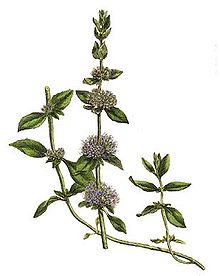Mentha pulegium
| Pennyroyal | |
|---|---|

| |
| Scientific classification | |
| Kingdom: | |
| (unranked): | |
| (unranked): | |
| (unranked): | |
| Order: | |
| Family: | |
| Genus: | |
| Species: | M. pulegium
|
| Binomial name | |
| Mentha pulegium | |
Pennyroyal (Mentha pulegium) is a plant in the mint genus, within the family Lamiaceae. Crushed Pennyroyal leaves exhibit a very strong fragrance similar to spearmint. Pennyroyal is a traditional culinary herb, folk remedy, and abortifacient. The essential oil of pennyroyal is used in aromatherapy, and is also high in pulegone, a highly toxic volatile organic compound affecting liver and uterine function.
Culinary and medicinal uses
Pennyroyal was commonly used as a cooking herb by the Greeks and Romans. The ancient Greeks often flavored their wine with pennyroyal. A large number of the recipes in the Roman cookbook of Apicius call for the use of pennyroyal, often along with such herbs as lovage, oregano and coriander. Although still commonly used for cooking in the Middle Ages, it gradually fell out of use as a culinary herb and is seldom used so today.
As an easily-made poison, pennyroyal has had a long historical use. Early settlers in colonial Virginia used dried pennyroyal to eradicate pests. So popular was pennyroyal, that the Royal Society published an article on its use against rattlesnakes in the first volume of its Philosophical Transactions (1665).[1]
Pennyroyal tea is the use of an infusion made from the herb. The infusion is widely reputed as safe to ingest in restricted quantities. It has been traditionally employed and reportedly successful as an emmenagogue (menstrual flow stimulant) or as an abortifacient. In 1994 a young woman died from an undetected ectopic pregnancy while performing a self-induced abortion using pennyroyal tea; reports say that she had consumed the tea for longer than the recommended five days.[2][3] The most popular current use of the tea is to settle the stomach [citation needed]. Other reported medicinal uses through history include treatment for fainting, flatulence, gall ailments, gout, and hepatitis (presumably Hepatitis A), and as a lung cleanser, a gum strengthener and, when ground with vinegar, a tumor remedy.[citation needed].
Toxicity
Pennyroyal essential oil is extremely concentrated. It should not ever be taken internally because it is highly toxic; even in small doses, the poison can lead to death. The metabolite menthofuran is thought to be the major toxic agent. Complications have been reported from attempts to use the oil for self-induced abortion. The oil can be used for aromatherapy, a bath additive and as an insect repellent. There are numerous studies that show pennyroyal's toxicity to humans and animals.[4][5][6][7]
Since the U.S. Congress passed the Dietary Supplement Health and Education Act in October 1994, all manufactured forms of pennyroyal have carried a warning label against its use by pregnant women. This substance is not regulated by the U.S. Food and Drug Administration.[3]
Pennyroyal oil should not be used as a natural flea repellent due to its toxicity to pets, even at extremely low levels.[8]
Historical and literary mentions
In the Homeric Hymn of Demeter, Demeter in the guise of an old woman as she searches for the abducted Persephone refuses red wine but accepts a drink of barley, water and pennyroyal called kykeon.
Aristophanes made reference to pennyroyal as abortifacient in Lysistrata and Peace. Mari Sandoz writes in her book, Slogum House, "She was the fifth of twelve children in the river-bottom family, with a mother who laid the cards and brewed tansy, pennyroyal and like concoctions for luckless girls who were in need."
The grunge band Nirvana recorded a song named "Pennyroyal Tea."
In the book Jitterbug Perfume by Tom Robbins, pennyroyal is used by Kudra to keep from becoming pregnant.
William Carlos Williams opens his 'Kora in Hell: improvisations' city lights books with "Fools have big wombs. For the rest? - here is pennyroyal if one knows to use it. But time is only another liar so go along the wall a little further......"
In the Mortal Engines by Philip Reeve, Professor Pennyroyal is a bogus historian who leads the protagonists of the story to near death.
See also
- Hedeoma pulegioides (American Pennyroyal, a distantly related species)
References
- ^ "Of a Way of Killing Ratle-Snakes". Philosophical Transactions of the Royal Society of London. 1: 43. 1665. doi:10.1098/rstl.1665.0022.
- ^ Young, Gordon (1995). "Lifestyle on Trial". Metro. Metro Publishing and Virtual Valley, Inc. Retrieved 2008-06-25.
{{cite news}}: Unknown parameter|month=ignored (help) - ^ a b Natural Standard Research Collaboration (2008-02-01). "American pennyroyal (Hedeoma pulegioides L.), European pennyroyal (Mentha pulegium L.)". Natural Standard. Retrieved 2008-06-25.
- ^ Carmichael PG (1997). "Pennyroyal metabolites in human poisoning". Annals of Internal Medicine. 126 (3): 250–1. doi:10.1059/0003-4819-126-3-199702010-00016. PMID 9027280.
{{cite journal}}: Unknown parameter|doi_brokendate=ignored (|doi-broken-date=suggested) (help); Unknown parameter|month=ignored (help) - ^ Anderson IB, Mullen WH, Meeker JE; et al. (1996). "Pennyroyal toxicity: measurement of toxic metabolite levels in two cases and review of the literature". Annals of Internal Medicine. 124 (8): 726–34. doi:10.1059/0003-4819-124-8-199604150-00004. PMID 8633832.
{{cite journal}}: Explicit use of et al. in:|author=(help); Unknown parameter|doi_brokendate=ignored (|doi-broken-date=suggested) (help); Unknown parameter|month=ignored (help)CS1 maint: multiple names: authors list (link) - ^ Bakerink JA, Gospe SM, Dimand RJ, Eldridge MW (1996). "Multiple organ failure after ingestion of pennyroyal oil from herbal tea in two infants". Pediatrics. 98 (5): 944–7. PMID 8909490.
{{cite journal}}: Unknown parameter|month=ignored (help)CS1 maint: multiple names: authors list (link) - ^ Sudekum M, Poppenga RH, Raju N, Braselton WE (1992). "Pennyroyal oil toxicosis in a dog". Journal of the American Veterinary Medical Association. 200 (6): 817–8. PMID 1568929.
{{cite journal}}: Unknown parameter|month=ignored (help)CS1 maint: multiple names: authors list (link) - ^ "Warnings about Essential Oils". Bits and Brew. Archived from the original on 2008-04-23. Retrieved 2008-06-25.
External links
Chisholm, Hugh, ed. (1911). Encyclopædia Britannica (11th ed.). Cambridge University Press. {{cite encyclopedia}}: Missing or empty |title= (help)
